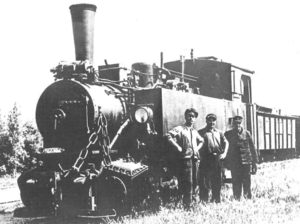Hohenzollern type mm
| Hohenzollern type mm | |
|---|---|
|
Locomotive 3mm of the Geilenkirchener Kreisbahn
|
|
| Numbering: |
Geilenkirchener Kreisbahn 3mm and 4mm Härtsfeldbahn 1–4 and others |
| Number: | 8th |
| Manufacturer: |
Hohenzollern serial number 1304–1306, 1472–1474, 1498, 1688 |
| Year of construction (s): | 1900-1903 |
| Retirement: | until 1958 |
| Type : | B'B n4vt |
| Genre : | K 44.8 |
| Gauge : | 1000 mm ( meter gauge ) |
| Length over buffers: | 8,350 mm |
| Length: | 7,460 mm |
| Height: | 3,540 mm |
| Width: | 2,400 mm |
| Total wheelbase: | 4,100 mm |
| Empty mass: | 25.3 t |
| Service mass: | 32 t |
| Friction mass: | 32 t |
| Wheel set mass : | 8 t |
| Top speed: | 30 km / h |
| Driving wheel diameter: | 860 mm / 848 mm |
| Control type : | Heusinger |
| Number of cylinders: | 4th |
| HD cylinder diameter: | 265 mm |
| LP cylinder diameter: | 395 mm |
| Piston stroke: | 400 mm |
| Boiler overpressure: | 14 bar |
| Grate area: | 0.98 m² |
| Evaporation heating surface: | 51.5 m² |
| Water supply: | 3 m³ |
| Fuel supply: | 1 t |
| Brake: | After conversion, indirect brake handbrake |
| Coupling type: | Balance lever coupling |
The Hohenzollern type mm of the West German Railway Company (WeEG) were meter-gauge, four - axle Mallet composite locomotives . From 1900 onwards, they ran on various lines of society. The locomotives were in service until 1958 and were then scrapped.
history
After the light Mallet locomotives procured by the Hohenzollern locomotive factory in 1899 proved their worth in operation, the West German Railway Company ordered eight more powerful locomotives. The locomotives differed only slightly from the lighter locomotives. They were able to pull a 728 t train on the plane. The WeEG initially gave the locomotives the designation 1m - 8m , where m meant the mallet type . Four locomotives were used on the Härtsfeldbahn , the locomotives there were designated 1 to 4 . To differentiate the light mallet locomotives, they were later given the designation 1mm to 8mm , whereby mm meant medium-weight mallet locomotives.
In 1914 and 1920 two locomotives were moved to the Geilenkirchener Kreisbahn . These were initially at the railway office Horrem stationed on the Bergheimer circular path in use, but also at times in the Brohltalbahn . In 1913 they were taken over with the Bergheimer Kreisbahn by the Royal Prussian Railway Administration and classified as T 35 with the numbers 83 and 84 , although they were shut down in May 1913 when the meter-gauge operation was shut down. In 1914 they were bought back by WeEG .
After the buyback, the 3mm was used at Euskirchener Kreisbahnen . In 1920 the machine came to the Geilenkirchener Kreisbahn. The 4mm was after a general inspection in the workshop Liblar in 1914 came the weeg to Geilenkirchener circular path.
The greatest inclination at the circular path was 20 ‰. There the locomotives were able to pull a train with three cars loaded on trestles or trolleys . Both machines were in use until 1957, but from 1955 they served as an operating reserve if one of the two diesel locomotives V 10 and V 11 failed . The locomotives received electrical lighting in the 1930s and welded water boxes after the Second World War .
construction
Mallet locomotives offered good conditions for moving heavy trains on winding routes with a weak superstructure. The two rear axles were firmly mounted in the frame with the high-pressure engine, which was designed as an inner frame. The front two axles with the low-pressure engine were mounted in an inner frame in a bogie that was connected to the main frame by a pivot pin. The boiler was supported by sliding plates on the bogie.
The locomotives had a compact design with a small wheelbase, a long funnel and a small boiler diameter. The type Hohenzollern Type lm they differed by the stronger boiler design, which required greater length and wheelbase. The procurement costs increased to 38,000 Reichsmarks .
The control was carried out with flat slides , whereby the valve boxes were inclined. The locomotives had two cuboid sandboxes that were controlled manually from the driver's cab. Later the locomotives were equipped with a line for steam heating .
When used on the Geilenkirchener Kreisbahn, the locomotives were fitted with two strong chains on the heater side, with which standard-gauge wagons could be pulled onto the trestle system. At the Geilenkirchener Kreisbahnen they originally had a Görlitz weight brake , later an indirect brake was used. The locomotives had the balancing lever coupling . To accommodate the coupling rod for trolleys or trolleys, the central buffer has two holes. An intermediate car with regular pulling and buffing equipment was also available for rolling carriage traffic .
Individual evidence
- ^ A b c d Henning Wall: The Geilenkirchener Kreisbahnen . Schweers and Wall, Aachen 2000, ISBN 3-89494-123-5 , pp. 98-101 .
- ↑ a b Gerd Wolff: German small and private railways . EK-Verlag, Freiburg 1997, ISBN 3-88255-660-9 , p. 19-38 .
